The world of William Wellman shows great overlap with that of the other great ‘masculine’ directors Raoul Walsh and Howard Hawks, just as there are considerable parallels in their biographies and personalities: Wellman got his start in the business as an actor, just like Walsh, and again like Walsh, and like Hawks, was known for his commanding personality, dashing good looks, debonair dressing style, high-profile Hollywood love affairs, bottomless drinking and relentless self-mythologizing. Like Walsh – and to some degree Hawks, who fought to get out of his contract with First National, a Warner subsidiary – he is primarily associated with Warner Brothers, although a lot of their major work was done at other studios. After having worked for Paramount up to 1931, Wellman perfectly synched with Warner’s new production chief Darryl Zanuck, whose taste for the barrelhouse crime saga and the Lower East Side exposé made possible both The Public Enemy and Walsh’s The Bowery (1933). Although he never saw any combat, Hawks was a flyer like Wellman, a topic both directors made several films about. The success of Wings paved the way for Hawks’ The Dawn Patrol (1930), another John Monk Saunders story, like Wellman’s Legion of the Condemned (1928).
Like Walsh, Wellman liked to put humor (often of the ‘low comedy’ type) in all his films, but made very few straight comedies. Hawks, of course, is one of the great masters of the genre: his Twentieth Century (1934) is often said to have ‘invented’ screwball along with Theodora Goes Wild, It Happened One Night and The Thin Man. Twentieth Century was written by Hawks’ friend and frequent collaborator Ben Hecht, whose The Front Page (co-written with Charles MacArthur) Hawks would so memorably gender-switch in His Girl Friday (1940). Hecht also wrote Nothing Sacred (1937), one of Wellman’s few comedies (along with 1942’s Roxie Hart), although almost every wit in New York had a go at the screenplay (the final credit reads like a who’s who of Algonquin round-tablers). If Nothing Sacred initially plays like a rerun of Capra’s Mr. Deeds Goes to Town (1936), with cynical New York newspaperman visiting backwater Vermont to hook up with local eccentric, the film shares most of its DNA with the Hecht-Hawks screwball comedies. Pauline Kael famously coined the moniker ‘screwball satire’ for Nothing Sacred, but it just as well applies to the Hawks films. When Carole Lombard and Fredric March start swinging at each other, we are reminded not only of the showstopper in Night Nurse when Clark Gable punches Barbara Stanwyck’s lights out, but also of that equally classic moment in Twentieth Century when Carole Lombard’s diva Mildred Plotka/Lily Garland starts kicking at her Svengali, theatrical impresario Oscar Jaffe, an immortal ham immortalized by the greatest ham of all, John Barrymore. Barrymore was supposed to be in Nothing Sacred, and it was because Selznick didn’t want him that Hecht finally dropped out of the production. Still, the cast of Twentieth Century is more than equally represented by Lombard and Walter Connolly, as game here in his reinvention of the cantankerous editor cliché as in his neurasthenic turn as Jaffe’s accountant.
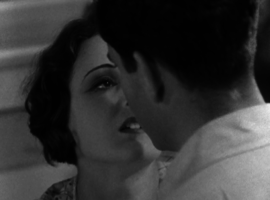
Like Hawks, macho man Wellman created some of the greatest women characters of the classical Hollywood period. Of the Wellman films we’ve seen so far at the Ritrovato, the standout performances have been those by Mary Astor in Other Men’s Women (1931) and Loretta Young in Midnight Mary (1933). As the dutiful and caring wife who falls in love with her nice-guy husband’s best friend, Astor is just as good at conveying the surprise and panic at being overcome by love, and at expressing the self-saving generosity of inviting her lover back into her life after her husband’s tragic death. On her face you can read the story of a life lived, a remarkably feat for a 25-year old actress, and no doubt one that was determined to an important extent by the circumstances of her own life (Astor had just had a nervous breakdown after her husband Kenneth Hawks, Howard’s brother, had died in a flying accident). In Midnight Mary Loretta Young shows the same combination of toughness and vulnerability, of trusting abandon and weary wisdom that would characterize that other great female performance of the early thirties, Barbara Stanwyck in Vidor’s Stella Dallas. In many ways, Young’s work in Midnight Mary already possess all the qualities she was praised for in Frank Borzage’s Depression fable, Man’s Castle two years later.
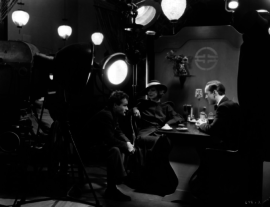
As already noted, there might be as many points of convergence between the Wellman of Nothing Sacred and the Capra of the Hecht-like journo satires Platinum Blonde, It Happened One Night and Mr. Deeds, as there are with Hawks. But the tone of Nothing Sacred is much darker than anything Capra would ever attempt (bar, perhaps, Meet John Doe). As screwball satires go, it doesn’t get more poisonous than a New York nightclub revue hosted by Frank Fay celebrating a young woman’s courage in the face of death with a pageant featuring ‘great women in history’, including both Pocahontas and Katinka, ‘who put her finger in the dike’. Or, in His Girl Friday, a Chicago editorial office rushing back to work after Mollie Malloy, girlfriend of convicted murderer Earl Williams (played by John Ford regular John Qualen, who fills a small role as a clueless fireman in Nothing Sacred with another offering of his ‘Swede’ act and his catchphrase, ‘By Jiminy!’), has just jumped out of its window out of sheer despair at the reporters’ inhumanity. Scenes like these are like the stoic-existentialist seen-it-all ‘Who’s Joe?’ routine from Only Angels Have Wings amped up to nightmarish levels. In Girl Friday Hawks and Hecht, in typical reflective fashion, even wink to Nothing Sacred’s Viennese doctor Emil Eggelhoffer (played by Sig Ruman, ‘Dutchy’ in Only Angels) by having Earl Williams examined by the court-appointed alienist Dr. Max J. Eggelhoffer (who gets ‘shot right in the classified ads’).
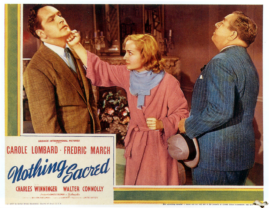
Many of Wellman’s Pre-Code films are extremely skeptical of government and the forces of law and order. In a film like Star Witness government officials are the ‘phonies’, the derogatory term for all manifestations of paternalism rendered famous by Salinger. This is why one of the stalwarts of the Depression era morality tale, Walter Huston, plays one of his least sympathetic characters in Star Witness, a role that’s basically an extension of the concerned citizens scene that was added to Hawks’ Scarface (1932) at the censor’s instigation. Similarly, the kindly New Deal judge that’s tagged on at the end of Wild Boys of the Road (1933) is the only thing in the movie that’s not ‘truthful’ and therefore not alive. But despite his scorn for the phonies, Wellman is not primarily a satirist. What he is, is a realist, something you could never really say about Hawks without smiling. By realism, as Bertrand Tavernier suggests in his fine piece on Wellman in Film Comment, however, we should mean something else than the predicate that usually gets attached to the social conscience picture of the Depression era.
For one, as we’ve already pointed out, Wellman’s politics are as confused as they are confusing. He was a conservative but one with mixed feelings not only about (big) government but also about the letter and application of the law. He made The Ox-Bow Incident (1941), which, together with Lang’s Fury (1936), is the most damning indictment of mob justice and, by extension, populism. But he also gives us, in Star Witness, a farce of a trial that is saved precisely by the kind of grassroots democracy incarnated by Charles ‘Chic’ Sale’s Civil War veteran, a character straight out of Irvin Cobb. He was a second-generation Irish immigrant who would have us sympathize with the same ‘Chic’ Sale hick character giving an Italian mobster (played by silent film director Ralph Ince) a good dressing down for polluting the Melting Pot, an expression of ethnic suspicion that is also at the heart of the concerned citizens scene in Scarface. He paints loving pictures of the American family, but never of the traditional kind: if you compare the family in Star Witness, with its stern patriarch played by another familiar face from Depression dramas, Grant Mitchell, to the substitute one in Wild Boys of the Road, it’s clear where Wellman’s true affection lies.
Tavernier makes the interesting point that directors like Wellman, or Ford or Walsh, industry pioneers who worked through all of its decisive eras, are hard to classify politically because they were so used to laying down their own laws in the Hollywood social system they helped build:
The director of Wings belongs to a generation of filmmakers who had become accustomed to being their own masters during the silent era. They often behaved like anarchists and would brook no interference. They had a reactionary bent, but that didn’t keep them from challenging taboos and restrictions. The producer, with few exceptions (Selznick seems to have had a creative relationship with Wellman), became the enemy as soon as he attempted to meddle. Wellman sent the producers of Wings to a field without telling them he was about to begin shooting a bombing sequence there; they left him alone for the rest of the project. He is also said to have dumped cartloads of manure in front of a studio mogul’s office.
All of these filmmakers — Wellman, Hawks, Ford, Walsh — were creating a new language, and their struggle was an apolitical one. Everything in this battle was of equal value: to shoot on location, to defy the Production Code, to direct a picture about lynching, to be the first to deal with taboo subjects.
This ‘battle’ that Tavernier speaks of also takes the form of a friendly competition between the filmmakers themselves. Taking great pride in a craft they would then casually dismiss as a ‘job of work’, they were obsessed with outdoing the other fellow, often using the same source material, the same kind of scene, the same players to achieve a superior and ever more competitive result. Both Hawks, Walsh and Wellman excelled at crisp continuity cutting, but when Hawks suddenly starts devising intricate crane and dolly shots in Scarface, I want to suggest you can see this as a direct response to Wellman’s technically accomplished camera style. I’ll get to this story in a later blog.
For now suffice it to say that an important aspect of Wellman’s realism, another way he did not conform to studio policy, was his insistence to shoot as much as possible outside the studio. The fact that he preferred to shoot en plein air, even if it was only Burbank, makes the feel of his films different from Hawks’ self-contained studio worlds. Manny Farber said about Wellman: ‘It may be a minor achievement, but, when Wellman finishes with a service station or the wooden stairs in front of an ancient saloon, there is no reason for any movie realist to handle the subject again.’ Wellman’s live and breathing locales, like those of Renoir (Tavernier also notices that a movie like Other Men’s Women (1931) is ‘closer to Renoir than to Lloyd Bacon or Ray Enright’), invite the kind of close scrutiny of contingent details that is typical of the Cahiers-inspired style of film criticism we’ve discussed at length in other blogs and that we also find in a critic like Manny Farber. That Farber likes Wellman as much as Hawks and Walsh, directors he puts forward as makers of ‘underground films,’ hard-edged genre films or B-movies without pretension to middle-brow notions of quality, has to do with Wellman’s similar feel for spatial arrangement, for the telling gesture or corner of the eye detail. In his piece on cinephilia for Cinema Journal, “Rescuing Fragments”, George Toles argues his point about the fragmentary nature of the film experience via a close reading of a number of sequences from Other Men’s Women, the mood of which exceeds the demands of the narrative, being more ‘truthful and enigmatic’ than the ‘jerry-built sections of the story.’
Documentary-like location footage was fairly typical of the Warner Brothers’ ‘taken from the headlines’ approach, but in Wellman’s films setting does not only function as synecdoche denoting ‘gritty realism’ but is closely tied to and even revealing of character in space. This idea is beautifully illustrated both in the final scene of the film, in which Grant Wither’s lovelorn train-engineer Bill White repeats a deliriously joyful run across the length of the train wagons – the joy of the moment recalled in Frankie Darro’s exuberant backflips at the end of Wild Boys of the Road – while Mary Astor’s Lily Kulper looks on wistfully from a roadside diner, and in its most unforgettable scene in which Regis Toomey’s blinded engineer Jack Kulper tries to feel his way across a rail yard to an engine that will take him to his doom and redemption in an apocalyptic but extremely tactile downpour, a Wellman staple. As George Toles describes the moment in phenomenological terms: ‘It is as though the milieu effortlessly begins to assert a reality stronger than the immediate dramatic circumstances. The space-time continuum has an unchallengeable thereness.’ To get a better sense of what Toles is getting at, look at a similar character, braving a similar torrential downpour, similarly trying to redeem himself through accepting a suicide mission at the same time that he is trying to come to terms with his wife having fallen for another man, in Only Angels Have Wings, where he’s played with equal tragic grandeur by Richard Barthelmess (forever associated with the John Monk Saunders Lost Generation type because of The Dawn Patrol, The Last Flight and Wellman’s Heroes for Sale, in which he plays a morphine-addicted veteran). Where Regis Toomey’s calvary is anchored in the materiality of the freight yard, Barthelmess’ last flight is watched over by a fake eagle on a studio-fabricated mountain control post.
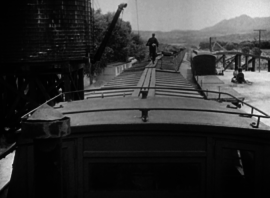
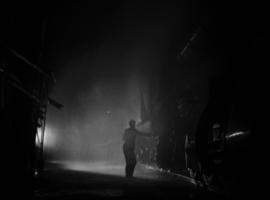
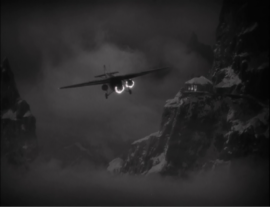
Also, these men work and their companionship, their loyalty is tied to the fact that they work together. It is often said of Hawks’s films that they concentrate on groups of professionals that adhere to a strict code. This is essentially true, but we never really see Hawks’ characters work, in the sense of performing a repetitive, everyday task that we find in Wellman and Walsh. Maybe this is because Hawks never really had to work for a living. In a Wellman film, and not just in the Depression films, you feel that these people have to make a buck to survive, whereas in a place like Hawks’ Barranca it seems that flying the mail is just another way to prove your sportsmanship, manhood and commitment to duty.
The film Other Men’s Women is closest to is probably Manpower (1941), Walsh’s drama about a crew of men working the power lines. Both films resemble each other not only in the way the working environment is brought to life, but in the central love triangle that ends with a fatal confrontation in a downpour. As has been often remarked, Manpower is a variation on the scenario already worked through by Hawks in Tiger Shark (1932), a story with weird Melvillean leanings about a tuna fishing boat skipper (Edward G. Robinson) who loses his hand trying to save his first mate and best friend (Richard Arlen) during a shark attack, and then loses his wife to the same friend. Wellman tones down the Freudian undertones of a plot that is as old as time itself (it turns up in Hawks’ Barbary Coast and, to some extent, in Only Angels Have Wings as well)but was probably borrowed from Sidney Howard’s 1924 play, They Knew What They Wanted (later made into a film by Victor Sjöström during his American period, again starring Edward G. Robinson).
The more important similarity, however, is that both films manage to perfectly balance their moments of high melodrama – the life-or-death confrontation during the storm – with an uncondescending and largely unsentimental view of the working class. One of the great merits of Walsh’s They Drive By Night (1940) is that it makes us accept Humphrey Bogart and George Raft as truck drivers trying to make a meager living hauling goods, and he performs the same magic with Raft and that other iconic gangster, Edward G. Robinson, in Manpower. Wellman does the same trick with Loretta Young, who had heretofore mainly played socialites or sophisticates, in Midnight Mary.The melodrama also fails to distract us from the convincing portrayal of everyday routine, both at work and at home, primarily expressed through ‘banter’. Again like Hawks, Wellman’s ear for dialogue insured an easy transition to sound. But although Wellman’s dialogue is certainly modern and slangy – part of the joy of a movie like Wild Boys of the Road comes from seeing kids like Frankie Darro and Edwin Phillips imitate the swagger of Cagney – these are not the bon mots and witticisms of the Algonquin wits or Ben Hecht’s rapid-fire zingers. Although pace is as important for Wellman as for Hawks or Walsh (after all, his movies from the thirties are usually wrapped up in seventy minutes; Nick Pinkerton has eloquently written about the ‘propulsive energy of Wellman’s films’ here), the dialogue in Wellman films, always succulent, depends on the beauty of colloquialism and natural language rather than the newspaper man’s barbed wisecracks.
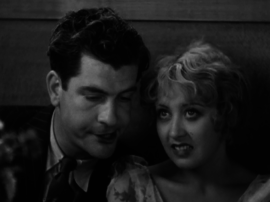
Scenes get stolen by supporting players but never in a self-congratulatory ‘hi ma!’ kind of way. There are two ways in which this happens: through sheer presence and through the handling of dialogue. A pre-Enemy Cagney shows up in two memorable scenes in Other Men’s Women as Bill’s friend and co-worker: in the first he leaps across those freighters with a dancer’s grace and a boy’s enthusiasm, and in the second he steps into a dance hall out of the pouring rain, announcing the arrival of the Thomas Hardy weather that will have such an important bearing on the plot. But then there’s Joan Blondell’s hash-house waitress Marie. She shines in an extended two-shot with Grant Withers in which, both drunk, they decide they should get married (the moment is recalled in Capra’s Mrs. Smith Goes to Washington in a similarly extended two shot of a drunk Jean Arthur and Thomas Mitchell, a sequence supposedly directed by a visiting Howard Hawks). Blondell also has the best line in the film, courtesy of Jazz Age playwright Maude Fulton: exchanging banter with Jack at the lunch counter, she tells him she’s ‘A.P.O.’, ‘Ain’t puttin’ out!’ The memorable line anchors the locale, the railroad yard lunch counter where the movie’s heartbreaking finale will play out, makes the place where the thing was said more likely to stick in the viewer’s mind. Like the wonderful movie that Other Men’s Women is.